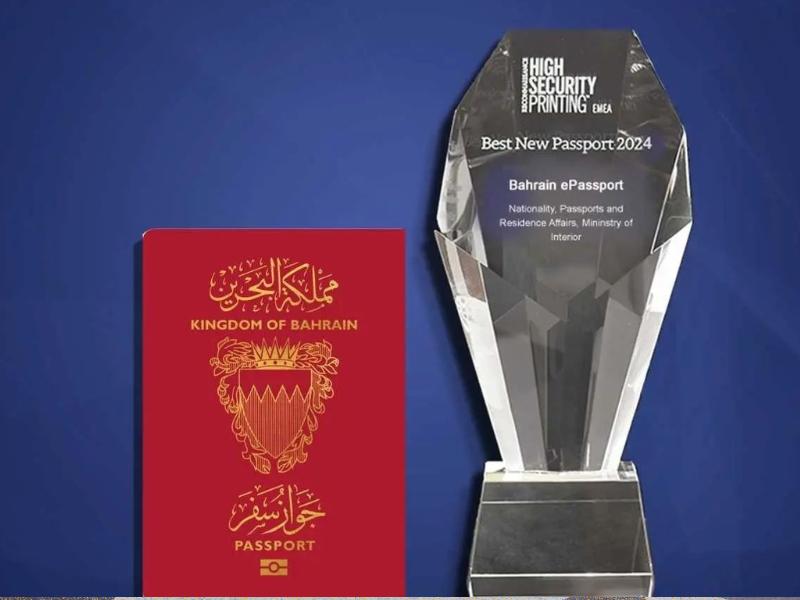The visionaries and designers behind the award-winning document share their thoughts on everything from advanced chips to holographic ‘mirages’.
The GCC now digitally transforms as a matter of course. Private sector innovators and public sector visionaries have their eyes on a glowing future of knowledge-based societies and tech-driven efficiencies. In the government sector, a recent shining example is Bahrain’s new ePassport, which took home three gold and seven silver plaudits at this year’s London Design Awards. Features include a “mirage” hologram image of the holder that disappears and reappears depending on viewing angle and lighting conditions.
Major Salman bin Ahmed Alkhalifa, Director of Bahrain’s Passport Directorate, said the nation was “motivated by a desire to lead in innovation and security”.
“This new passport, designed to reflect Bahrain’s unique culture and heritage, boasts advanced security features like biometrics and encryption to combat fraud and safeguard travel documents,” he said.
For HID– the identity solutions company that implemented Bahrain’s vision – the fulcrum of the entire project was trust.
“It is crucial to include security features to prevent counterfeiting and fraudulent alterations,” said Matthew Sugdon, Ph.D., Director of Security Graphics and Partners at HID. “Bahrain’s ePassport has a polycarbonate data page, a color portrait, ultraviolet and holographic features, and advanced chip technology.”
Modern passports come with dozens of security features. When designing the document, Sugdon explained, everything from aesthetics to security has to be aligned with the requirements of practicality and reliability. For the Bahrain project, there was an added need – that the ePassport reflect the nation’s culture. So, HID designers spent time on the ground, working with local artists and calligraphers, and took original photographs that were eventually included in the passport.
Major Alkhalifa lauded the passport as potentially “revolutionizing travel for citizens” by providing “a secure and efficient leap forward”.
“Seamlessly aligned with national security and international travel goals, this passport streamlines border control, saving valuable time and hassle for travellers,” he said, “all while ensuring compliance with international standards. [We therefore] strengthen Bahrain’s security infrastructure and promote seamless international travel for all.”
HID’s Mirage feature combines different security best practices to make documents difficult to reproduce. One strategy is to multiply the number of times the portrait (“one of the most commonly attacked elements”, according to Sugdon) appears within the passport. And to prevent the replacement of the data page (another common attack method), HID created Safelink, which adds a continuous UV print pattern that runs through the data page, making it easier for border officials to spot tampering.
“There is a tremendous amount of work, care, and expertise required to capture and represent symbols that reflect the spirit of a nation, while also integrating state-of-the-art security features to protect the personal data stored within a passport,” Sugdon explained. “HID’s thought-leadership position in the market can be seen not only in the security features that we develop in-house, such as HID Mirage and HID Safelink, but in the entire ePassport, from component selection to the design and operating system of the chip.”
The ePassport also stores the biometric and biographic data of its holder in an advanced chip. Bahrain now joins the International Civil Aviation Organization’s (ICAO) Public Key Directory (PKD) of 180 countries that can access and exchange electronic passport data. By verifying digital signatures on the ePassport’s chip, border control agencies can confidently confirm the document’s authenticity. Among its future plans for the ePassport, the Bahraini government is looking at advancements in biometric authentication, encryption techniques, and data protection.
“The government aims to stay ahead of potential threats and adhere to international standards while providing its citizens with the most secure and technologically advanced travel document possible,” said Major Alkhalifa.
“In the Bahrain ePassport, we added many cultural and historical elements that are unseen until the pages are flashed out in ultraviolet light,” said Sugdon. “If you flip through the booklet under UV light, you can even follow a stallion and peregrine falcon as they gallop and fly across the pages.” “Bahrain’s ePassport design goes beyond aesthetics,” said Major Alkhalifa. “It tells a story of the nation’s heritage through symbols like horses, falcons, and the Suhail star, reflecting its connection to nature, tradition, and maritime history. This blend of past and present, with modern landmarks alongside cultural motifs, makes the ePassport more than just a document; it’s a symbol of national pride and a window into the soul of Bahrain.”






